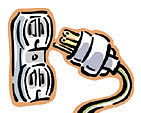Fan
The fan is the combination of blades that spin around to create the airflow to produce the vacuuming action.
HEPA
HEPA stands for High-Efficiency Particle Arrestor, used to reduce the number of contaminants in indoor air. A HEPA filter will arrest or stop 99.97% of all particles .3 microns or larger.
This is highly recommended for allergy suffers.
Horsepower
Central vacuums are not rated in horsepower.
Hoses - Crushproof & Wire Reinforced
A central vacuum hose, more than any other component, impacts the overall performance of your central vacuum. The reason for this is friction which occurs inside the length of the hose. Crushproof style hoses suffer considerably less performance loss than their wire reinforced counterparts, this is because the interior of a crushproof hose is smooth thus resulting in less turbulence. Therefore choosing a hose which is crushproof over a wire reinforced hose will give you better cleaning power right away. Basically, there are two types of hose construction available, crushproof or wire reinforced. Most companies offer the crushproof style hose simply because it has superior benefits such as being lightweight, offers better airflow and being that it is "crushproof", it springs back to shape after being stepped on or crushed. Even the diameter of a hose results in performance gain or loss. Choosing a hose which has a diameter of 1-3/8" compared to 1-1/4" results in most cases a 20% improvement in airflow performance. When choosing a hose for your system, make sure that it turns the unit and the power nozzle "on" and "off". In addition, the hose you choose should also be equipped with a 360-degree swivel handle. This reduces hose tangle and wrist strain.
Crushproof Hoses Are Better
Motor Brushes
The sliding contacts that provide electrical power between the stationary stator and the rotating armature of an electrical motor. Brushes are the most wearable part of an electric motor and should be replaced every few hundred hours or few years of operation.
Paper Bag
With a bag unit, the incoming dirt is separated from the air stream by the bag. Different brands use cloth bags, paper bags or both. The air is filtered before going through the motor thus extending motor life. There is also no need to exhaust the system outside because the exhaust air is relatively clean. This method is the cleanest and hygienic way. Paper bags eliminate mold and bacteria from growing. No cleaning of the canister is required. Takes 30 seconds to change a bag. Just that easy.
Polycarbonate
A high-performance plastic, engineered to be tough and robust. It is used for strength and durability. Polycarbonate resists scratching, has an attractive sheen, and is the same plastic as the so-called 'bulletproof glass'.
Power Nozzle
Designed to loosen stubborn dirt in carpets, and make it available for removal by the air flow. Power nozzles are optimally designed to remove dirt. The beater bar agitates and vibrates the carpet, to loosen the type of dirt that can get down between carpet fibers, like sand.
Sealed Bearings
Often used in high-quality motors to prevent dust and debris from entering the motor bearing area.
Sealed Suction
Measures the maximum suction generated by the motor without airflow.
Stage
This indicates the number of sets of fan blades in a vacuum motor. Each fan - set of blades - increases the vacuum or speed at which air is drawn through the system. The first fan starts air movement; the second increase it, and if there is a third fan it increases airflow still more. Thus the greater the number of fans the more powerful the vacuum.
Suction
The actual vacuum created by the fans in the vacuum motor.
Teflon
Slippery, non-stick material.
Turbo Nozzles (Air Driven)
Turbo Nozzles run off the airflow of your central vacuum system only. No electrical cords or electricity are required, meaning that it is a less powerful nozzle. This is for low pile carpeting and some medium pile carpeting only.
Vacuum
A total vacuum is the absence of everything, even air. Vacuum cleaners actually create a partial vacuum,
or more accurately, an area of reduced air pressure, as air moves outward within the fan. Airflow is created as air with normal air pressure moves toward the area with the reduced air pressure.
Voltage (Volts)
A measure of the electrical potential employed by a vacuum motor. Typically, motors require common household current; 110-120 in North America; 240 volts in other parts of the world. Voltage is to electricity as pressure is to water; a measure of potential or driving force.
Waterlift
This measures the suction strength of a central vacuum motor. Essentially, it tells how much "pull" or "lift" power the motor has. This measurement is always taken at its maximum value, the 0" inch orifice (sealed vacuum) where suction is at it's greatest. Since this measurement is taken from the 0" orifice, it is very misleading. This measurement does not take into account piping, hoses or accessories etc., thus giving a false measurement of power. Often referred to as Inches or Waterlift or Vacuum, Suction is vital to overall system performance since it is the "pull power" that maintains Airflow though the complex network of vacuum pipe, hose and accessories. While Airflow is necessary for a vacuum cleaner to work, suction creates the lift and velocity of air which sweeps dirt away. Waterlift is NOT a true measure of suction, however it is a form of measurement and part of the equation when measuring Air Watts. This is the most misleading measurement of suction power. Please note certain companies will inflate this number to influence a consumer by making the suction power appear stronger - Wrong!







Log In
Create New Account